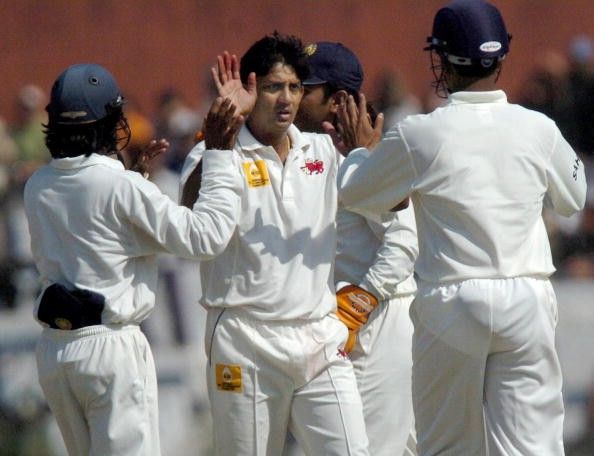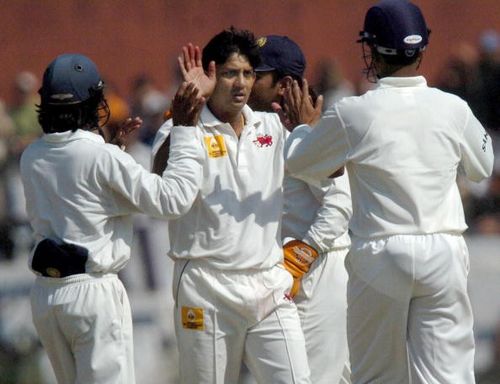
Sairaj Bahutule: Indian domestic cricket legend who couldn't succeed at the international level

The life of a budding cricketer has more ups and downs than your average Bollywood script. The harsh realities of failure directly contrast the sweet feeling of success and seldom is the road to the international level a bed of roses.
The Indian team has had the fortune of witnessing a golden era, a timeline involving many great cricketers in the team at the same time. The early 2000s saw a lot of transitions in the team, but due to a settled unit later on, many fringe players were unable to make their way into the team and make their career at the top level.
Sairaj Bahutule was one such player, who overcame personal difficulties to don the national colours. One of the exponents of the rare art of the leg break, Bahutule could have gone on to be a vital cog in the Indian lineup at the turn of the new millennium. As luck would have it, he was born in the era of Anil Kumble, arguably India’s greatest Test bowler and a direct contrast to Bahutule’s mode of classic leg spin.
A difficult start to life & cricket
Bahutule graduated from his school team with the likes of Sachin Tendulkar and Vinod Kambli. He was on the receiving end of the record-breaking thrashing that brought the duo into the limelight. The 664 run partnership in the Harris Shield Tournament had such a trauma on the St.Xavier’s bowlers that Bahutule had to convince them to return to the field the next day. He himself returned with insipid figures of 0-182 in 27 overs and played a lone hand of 69 in his team’s meagre response of 154.
His story of struggle had a torrid beginning when a car carrying him crashed into a public bus in the middle of a July evening in 1990. The driver of the car, Vivek Singh, son of legendary singers Jagjit and Chitra Singh, died on the spot. The accident sent Bahutule into coma straight away. When he came to his senses, he lay in bed with a fractured right femur bone and a crushed left elbow. A seventeen-year old’s dreams suddenly lay quashed in front of him.
A steel rod was inserted to assist his broken leg. Bahutule recalls several instances when the leg used to pain a lot whenever he exerted himself. The injury had serious repercussions for the next year and a half. He failed to join his collegiate team and could barely make it to a few metres in the trials.
However, Bahutule would recover handsomely to establish himself as one of the country’s top-rated all-rounder in the domestic circuit for close to two decades.
Domestic career
However, by the end of the following year, he was playing in the Ranji Trophy. In his first match back from injury, his match figures stood at 4-81. The following year started on a sweeter note, with an impressive maiden century against Maharashtra, the team he would eventually play for in the twilight of his career.
Crucial contributions with both bat and ball in the 1993-94 finals, and his first five-for in the Irani Trophy in the subsequent season made him one of the most promising leg spinners in the domestic circuit.
Even though his handy contributions with the bat gave him an edge over his competitors, he was still far away from breaking his way into the Indian team, with the likes of Kumble, Venkatapathy Raju and Rajesh Chauhan hogging most of the spinners’ slots that were available. Narendra Hirwani, whose talent had been on display right from his debut match, was also waiting in the wings.
His all-round prowess was the highlight of two Ranji seasons, separated by almost a decade. In 1993-94, he stacked up 387 runs and picked up 35 wickets. The next best season came in 2003, when the wicket tally went up to 40 wickets, apart from amassing 315 runs. Both the efforts culminated in Mumbai winning the Trophy, a total of six times in the ten year period.
The Irani Trophy in 1997 turned out to be even more memorable, with 13 wickets in his kitty. That included an eight-wicket haul in the second innings. The only two players to ever emulate the feat were Anil Kumble and Murali Kartik, the former returning with eleven wickets in the same match for Rest of India. The performance was instrumental in Bahutule getting into the Indian team the very next year.
He changed sides in August 2005, completing a move from Mumbai to Maharashtra after a fifteen-year career. The move, along with that of Nilesh Kulkarni and Munaf Patel, left quite a void in the Mumbai line-up. 2003-04 had been a memorable year for him, finishing as the highest wicket taker in all Ranji competitions. His captaincy was instrumental in Mumbai winning back to back Ranji Trophies 2002-03 and 2003-04.
After three years at Maharashtra, he returned to his hometown in 2008. Before finally moving to Vidarbha in the twilight of his career, he had small stints in Assam and Andhra. In the process, he became only the ninth bowler ever to take 400 Ranji wickets.
ODI career
Bahutule’s ODI debut was against Sri Lanka at the Nehru Stadium in Guwahati. He was the third bowler to be introduced into the attack, right after Rajesh Chauhan, the off-spinner with whom Bahutule was vying for the spinner’s slot in the team. He returned with decent figures, giving away 33 runs in 9 overs. The match, however, belonged to Robin Singh, who listed career best figures of 5-22.
Bahutule had to wait for two more matches to claim his first ODI wicket. The victim was Roshan Mahanama and he was one of the only two wickets that Bahutule could manage in his eight-match career, the other being Saeed Anwar. His career bowling average of 142 doesn’t do justice his career, especially in comparison to his 197 ListA wickets at an impressive average of 26.
After a five and a half year hiatus and 779 One Day Internationals later, Bahutule made a comeback, a return to the national side that lasted a solitary match. He was clobbered for 24 runs in the three overs he could manage.
Test career
Bahutule made his Test debut in India’s historic series against Australia in 2001, termed as the ‘Final Frontier’ by Steve Waugh. The debutant ran into a belligerent Matthew Hayden, the destroyer of many a spin attack, going on to compile his first double hundred. He managed to take the wicket of Mark Waugh after the younger twin had looked solid in his knock of 70.
He came back in the second innings to take the wicket of Justin Langer. With just one more scalp added to his overall Test wickets column, however, meant that Bahutule couldn’t realize his potential in the longer format either.
The other leg-spinner in the match, Shane Warne could also manage only two wickets. Harbhajan Singh, however, took seven wickets in the first innings, and bettered the effort with eight in the second one, becoming only the second Indian spinner after Narendra Hirwani to take fifteen or more wickets in a Test match.
To put things into perspective, his first-class statistics were far more impressive, with 630 victims in 188 matches.
India’s never ending search for an all-rounder
One thing that Bahutule might regret is not contributing enough with the bat. The team needed, and still needs, a genuine all-rounder in the side, and Bahutule, with loads of experience in the domestic circuit, fit the bill perfectly.
In an interview few years back, the Mumbaikar had lamented that the selectors weren’t as persistent with youngsters back then as they are now. The Indian selectors tried a lot of allrounders in the 2000s, and few could carve out a respectable career from the opportunities they got. Ajit Agarkar, Bahutule’s Mumbai teammate, was one of the few to get a long run, and even he couldn’t contribute as consistently with the bat as his first class career showed.
In 2003, when his start-stop career was heading for a premature end, he was snubbed from the Challenger trophy squads but was later reinstated by Chandu Borde, the chief selector. Anil Kumble had been around for more than a decade, Harbhajan Singh had had a successful World Cup and Amit Mishra, the young leg-spinner from Haryana, was knocking on the selectors’ doors with consistent performances at the domestic level.
Bahutule’s edge, however, was in his batting prowess, which was more than just decent. With nine centuries at an average of 32, Bahutule would have surely been a welcome asset to the Indian squad in the early 2000s. Hemang Badani, Dinesh Mongia, Sanjay Bangar and JP Yadav were all tried, but not a single all-rounder could carry on for long.
Bahutule finished his career in August 2013, with 630 wickets and 6176 runs at the domestic level, scoring 17 and 0 in his last match, apart from being wicketless. The disparity in the records is a sad tale of a career unfulfilled, but Bahutule will forever be remembered in the domestic circles as someone who epitomized endurance and mental strength.